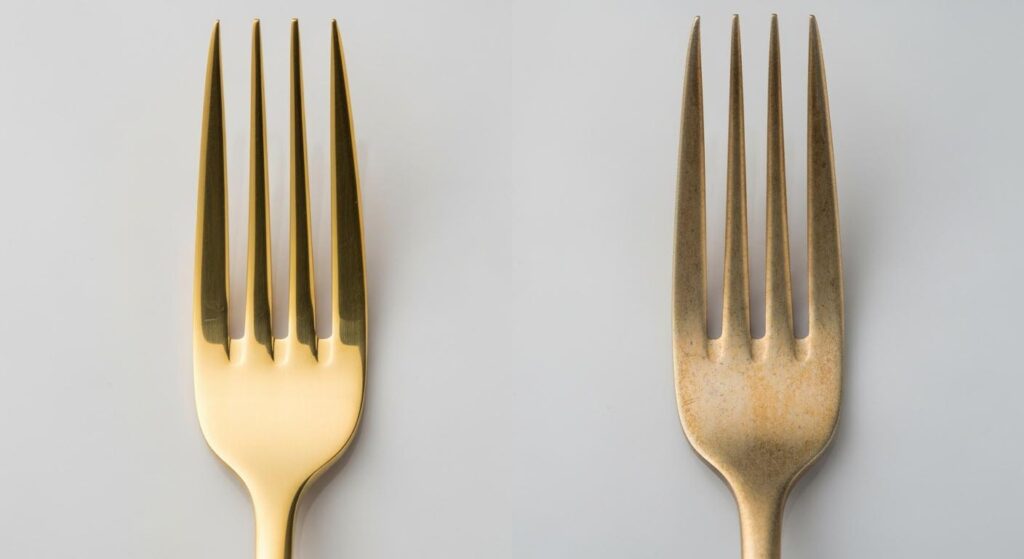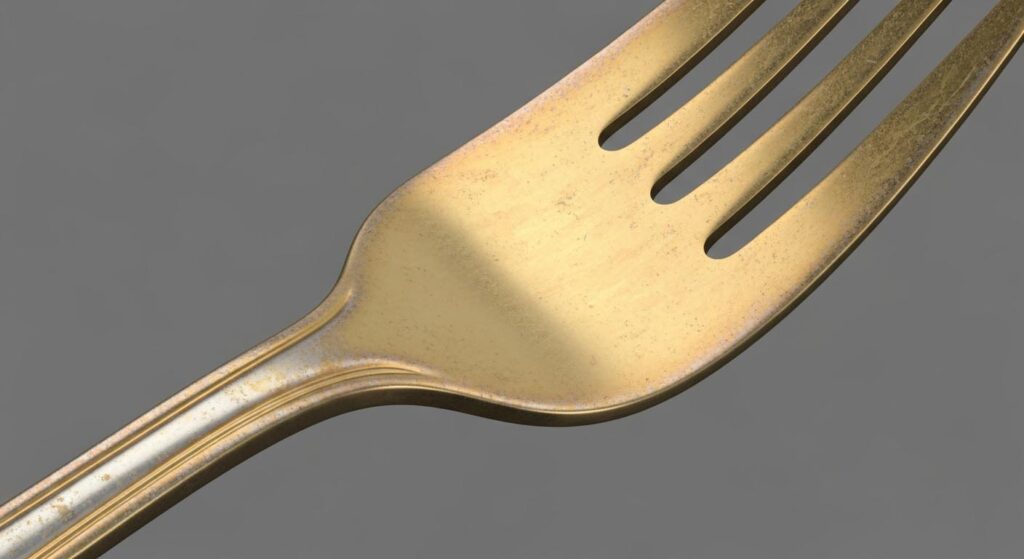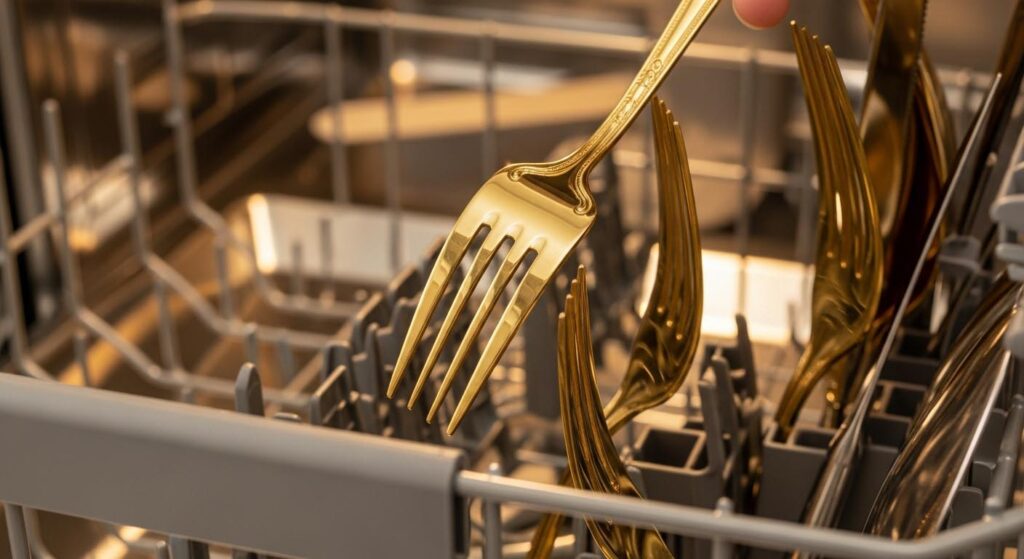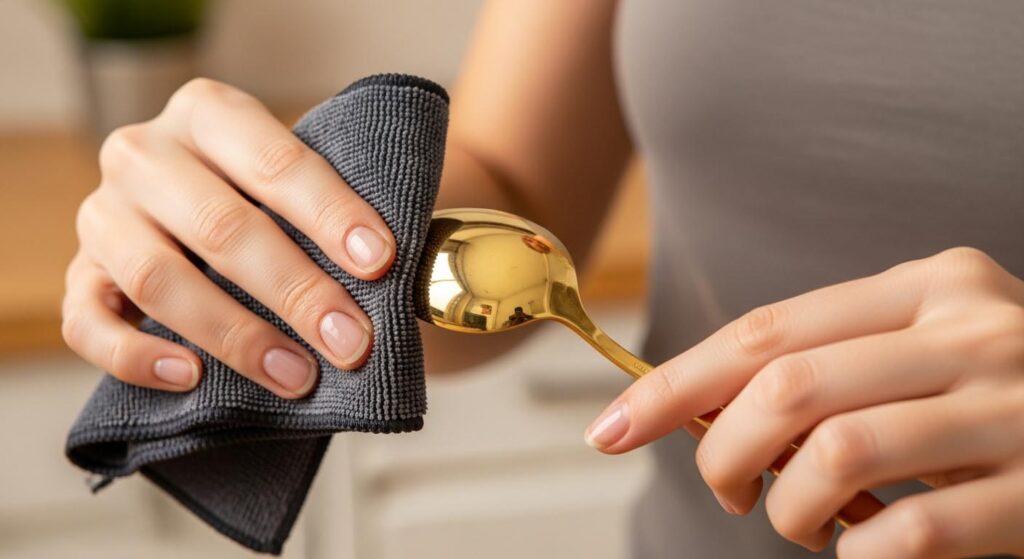Is gold-plated flatware safe?
You love the gorgeous look of gold flatware, but you're hesitant. You wonder if the gold will chip off into your food, or if it's even safe to use every day.
Yes, modern gold-colored flatware is completely safe when made with PVD coating, which molecularly bonds a durable, inert layer to the steel. Older, traditionally electroplated flatware is safe only as long as its thin plating is intact, making it less durable for regular use.

I get asked this question constantly, from home cooks to professional buyers like Jacky from a major U.S. brand. His primary concern is always safety and durability. The answer isn't a simple yes or no; it depends entirely on the technology used to create the gold finish. There are two main methods—an old one and a new one. Understanding the difference is the key to knowing if your gold flatware is beautiful for a night or beautiful for a lifetime. Let's break down exactly how it works.
How long does gold-plated silverware last?
You've invested in a stunning gold cutlery set, hoping for lasting elegance. But you have a nagging fear that it will chip, fade, and look cheap after just a few months.
Gold flatware made with a modern PVD coating can last for more than 10 years, even with daily use and dishwashing. Traditional gold electroplating is far less durable and may show significant wear and fading in just 1-3 years.

The lifespan of gold-colored flatware comes down to one thing: how the gold layer is applied. There are two completely different worlds of quality.
-
PVD (Physical Vapor Deposition1): This is the modern, superior method. Inside a high-tech vacuum chamber, we vaporize a durable ceramic compound like Titanium Nitride (which has a brilliant gold color) and bond it to the stainless steel at a molecular level. It’s not just a layer on top; it's integrated into the steel's surface, making it incredibly hard and long-lasting.
-
Traditional Gold Electroplating2: This is an older method where an electric current is used to deposit a very thin layer of real gold onto the steel. It's like applying a thin skin of paint. While beautiful at first, this layer is soft, thin, and prone to scratching and wearing off with use.
In my factory, we've shifted almost entirely to PVD for all our colored flatware. It's simply a better, more durable product that meets the demands of modern life.
Durability Comparison
| Method | Scratch Resistance | Dishwasher Safe? | Typical Lifespan (Daily Use) |
|---|---|---|---|
| PVD Coating | Excellent | Yes, with care | 10+ years |
| Electroplating | Poor | Not recommended | 1-3 years |
Does gold-plated rust over time?
You notice a tiny, dark spot on your gold fork. Your heart sinks. Is it rust? You worry the beautiful finish is failing, exposing the metal underneath and ruining the set.
The gold coating itself, whether PVD or electroplate, cannot rust. However, if the coating on a cheaply made, electroplated item is scratched, the underlying steel can be exposed to moisture and potentially rust, causing the plating to flake.

Let's be clear: gold is a noble metal, which means it is chemically stable and does not rust. The material used for PVD coating, titanium nitride3, is also extremely resistant to corrosion. So, the "gold" part of your flatware is not the problem. The risk comes from what’s underneath. All gold flatware starts as stainless steel. The difference is how well the gold coating protects that steel.
With a PVD coating, the bonded layer is so hard and complete that it effectively seals the stainless steel from the outside world. It is extremely difficult to scratch through to the base metal. With traditional electroplating, the gold layer is thin and soft. It can be easily scratched by other utensils or abrasive cleaners. Once that protective skin is broken, water and detergents can seep underneath and attack the steel base. If it's a lower-grade steel, it can begin to rust. This rust then creeps under the plating, causing it to bubble and flake off. So, if you see rust on gold flatware, it's a clear sign of a failed, low-quality electroplated coating.
Can gold-plated flatware be washed in the dishwasher?
You want the glamorous look of gold flatware but not the chore of hand-washing. You're afraid to put it in the dishwasher, fearing the harsh environment will strip the finish.
Gold flatware made with a PVD coating is generally dishwasher safe. In stark contrast, traditional gold electroplated flatware should always be hand-washed, as the combination of high heat and harsh detergents will quickly destroy the delicate finish.

This is one of the most important practical questions I get, and the answer, once again, comes down to PVD vs. electroplating. The dishwasher is a hostile environment, and only the strong survive.
The PVD finish is strong enough. The coating is incredibly hard—often harder than the steel itself—and is highly resistant to the abrasive force of water jets and the chemical action of detergents. We still recommend some best practices, like using a gentle detergent without citric acid and a good rinse aid, but PVD flatware is engineered to withstand daily dishwasher use.
The dishwasher is the number one killer of traditional electroplated flatware. The thin gold layer is attacked from all sides. The high heat can weaken the fragile bond between the gold and the steel. Harsh, gritty detergents act like sandpaper, literally scrubbing the gold away. Finally, high-pressure water jets can easily get under any tiny scratch, peeling the plating off in sheets. I give this simple advice to everyone: if a brand says its gold flatware is dishwasher safe, you can be confident it's made with PVD. If it says "hand-wash only," it's electroplated.
How to prevent gold-plated from tarnishing?
You associate precious metals with tarnish, just like silver. You worry that your shiny gold cutlery will slowly become dull and discolored, forcing you into a cycle of constant polishing.
True gold and modern PVD coatings do not tarnish. Tarnish is a specific type of corrosion that affects silver, not gold. Any dullness or discoloration on gold flatware is typically a surface film from water or soap, which can be easily wiped away.

It's important to understand what "tarnish" actually is. Tarnish is a chemical reaction that creates a layer of corrosion, like the black silver sulfide on sterling silver or the green patina4 on copper. Gold is one of the most chemically non-reactive metals on earth. It simply does not tarnish. Likewise, the ceramic PVD coating is also chemically inert5. So, you can relax—you will never need to polish your gold flatware to remove tarnish.
So what is that dull film you might sometimes see? It's almost always one of two things. First, it could be residue from hard water minerals or dishwasher detergent that didn't fully rinse away. This is easily fixed by wiping the utensil with a soft cloth dampened with a bit of white vinegar, then rinsing and drying. Second, on a highly polished finish, thousands of microscopic scratches can build up over time, which scatters light and makes the surface look dull. This is a much bigger issue for soft electroplating. The extreme hardness of a PVD finish makes it highly resistant to these micro-scratches, so it keeps its brilliant shine for much, much longer.
Conclusion
Modern gold flatware is safe, durable, and beautiful. The key is to choose sets made with PVD technology. This ensures the finish won't chip, rust, or fade, even in the dishwasher.
-
Explore this link to understand how PVD technology enhances durability and aesthetics in metal coatings. ↩
-
Learn about the limitations of electroplating and why PVD is often preferred for long-lasting finishes. ↩
-
Exploring titanium nitride will reveal its significance in various applications, including its role in enhancing durability. ↩
-
Explore this link to understand the fascinating process of patina formation and its significance in metal art and preservation. ↩
-
Exploring this resource will deepen your understanding of chemically inert materials and their significance in various applications. ↩
